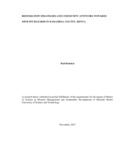| dc.description.abstract | Mining is an economic activity that has been practiced for time immemorial. Land
degradation from old mines operations is known in almost all the countries but they have
been few systematic surveys to quantify the nature of associated problems so as to prioritize
remediation action. There is knowledge in the techniques of rehabilitating both operational
and abandoned sites yet there is still delay in remediation action. The enforcement of the
Environmental Management and Co-ordination Act (EMCA) of 1999 was envisaged to go a
long way in managing negative impacts of mining, quarrying and sand harvesting. The
National Environment Management Field Dataity on the other hand, controls the restoration
fund meant for the mitigation of environmental degradation. There is however very little
rehabilitation works that have been done on old mines and quarries in the country. The study
was conducted in Kakamega County and the study population drawn from 18 mine pits in
Kakamega County. The respondents were drawn from the Sub-County Environment
Committees, Mine Geologist Experts, Miners, Constituency Roads Committees, Association
of mining companies, Construction Companies, County Government Environment
Committees, local Administration, land owners of mine pits and residents neighboring the
pits. The researcher employed evaluation research design, purposive sampling and
systematic random sampling techniques. Data collected was summarized in tables and bar
charts. The data was analyzed using descriptive statistical analysis, analysis of variance
(ANOVA) and chi-square the results indicated that there were many abandoned mined pits in
the County, whose restoration strategies are not effective. The findings showed that there
were several mining activities in Kakamega County including; Gold mining 26% (38), sand
harvesting 22% (37), quarry mine 17% (28), murrum 15% (25) and soil mining 20% (14).
Mining activities had environmental degradation effects indicated by loss of vegetation 45%
(75), soil erosion 20% (33), low farm yields 15% (25), contamination of water bodies and
root exposure at 10% (17). Open mine pits were areas for mosquito breeding thus increasing
prevalence of malaria in the community. These effects created different attitudes in the
community basing on social class and education. The strategies in place for restoration of
mine pits are not implemented due to lack of enforcement. This has finally made abandoned
mine pits a hazard to the community. It was recommended that the County Government of
Kakamega should revisit its laws on the restoration of mined lands. The community should
be made aware of other benefits of mine pits and change their attitude towards them. | en_US |

